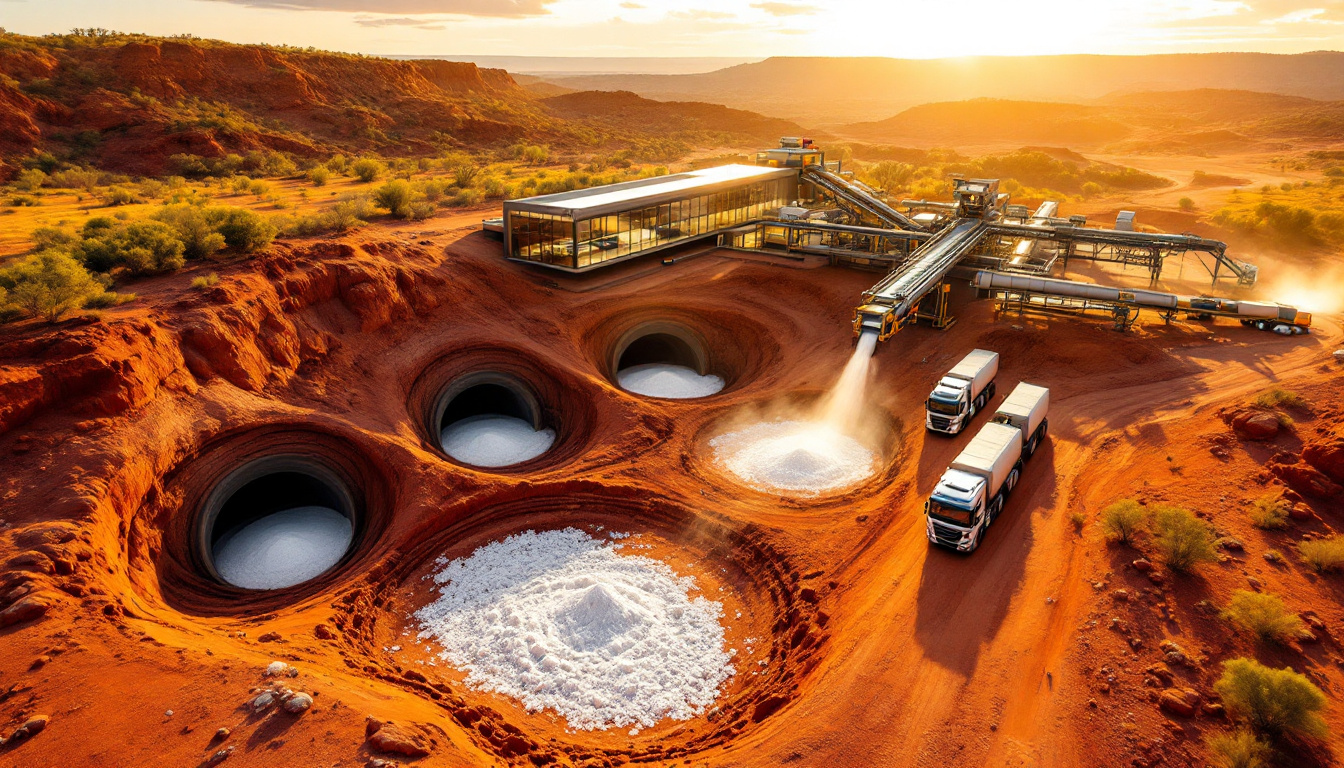What Is Bioleaching in Copper Mining?
Bioleaching represents a groundbreaking biotechnological approach to extracting copper from ores using microorganisms. This innovative process harnesses naturally occurring or bioengineered bacteria and other microbes to solubilize copper from minerals that would otherwise be difficult to process using conventional extraction methods.
The technology has gained significant attention as the mining industry faces increasing challenges with declining ore grades and growing demand for copper price insights in the global transition to renewable energy and electrification.
The Science Behind Bioleaching
Specialized microorganisms oxidize sulfide minerals in copper ores, converting insoluble copper compounds into soluble forms that can be easily recovered. This biohydrometallurgical process relies on the metabolic activities of acidophilic bacteria such as Acidithiobacillus ferrooxidans that thrive in the harsh, acidic environments typical of mining operations.
These remarkable microorganisms catalyze oxidation reactions, effectively dissolving copper minerals through natural biochemical processes. The bacteria oxidize iron and sulfur compounds in minerals like chalcopyrite (CuFeS₂), creating ferric iron and sulfuric acid, which further dissolve the copper into solution.
Historical Development of Bioleaching Technologies
Bioleaching has evolved from an observed natural phenomenon to a sophisticated biotechnological application. Early mining operations unknowingly benefited from natural microbial activity, with documented cases dating back to the Rio Tinto mines in Spain, where acidic, copper-rich water was collected from mine drainage as early as 1000 BCE.
Modern approaches deliberately cultivate and optimize specific microbial communities for enhanced metal recovery. The first commercial application of controlled bioleaching began in the 1950s, but significant advancements in understanding microbial leaching processes have transformed the field in recent decades.
What was once considered a curious natural occurrence has developed into a cutting-edge technology with increasing industrial adoption. Early implementations at Chile's Escondida Mine for waste treatment demonstrated the potential for bioleaching to complement conventional extraction methods.
Why Is Bioleaching Becoming Critical for the Copper Industry?
The Growing Copper Supply-Demand Gap
Copper demand is projected to double by 2035, reaching approximately 50 million metric tons annually—enough to manufacture 600 million electric vehicles, according to comprehensive analysis by S&P Global (July 2022). This surge is driven by the metal's essential role in renewable energy infrastructure, electric vehicles, and digital technologies.
The explosive growth in demand comes as copper's role in the green energy transition becomes increasingly vital. A typical electric vehicle requires up to four times more copper than a conventional internal combustion engine vehicle. Similarly, renewable energy systems like solar panels and wind turbines need substantially more copper per megawatt than traditional power generation.
With the global push toward net-zero emissions accelerating, copper investment outlook and its status as a critical mineral for decarbonization creates unprecedented pressure on supply chains.
Declining Ore Grades and Processing Challenges
Since 1991, copper ore grades have decreased by 40%, with approximately 70% of known reserves trapped in low-grade or difficult-to-process deposits, according to BHP Insights (September 2024). This decline necessitates innovative extraction methods to maintain economically viable production.
As mining companies exhaust easily accessible, high-grade deposits, they're forced to process lower-quality ores that would have been considered uneconomical in previous decades. Legacy extraction methods like pyrometallurgical smelting become increasingly energy-intensive and cost-prohibitive as ore quality decreases.
In this challenging context, bioleaching in copper mining offers a viable alternative for processing these otherwise stranded resources that conventional methods cannot economically handle.
Sustainability Imperatives in Mining Operations
Traditional copper extraction methods often involve significant environmental impacts, including high energy consumption, water usage, and waste generation. The mining industry faces increasing pressure to adopt more sustainable practices while meeting growing demand.
According to the International Council on Mining and Metals (ICMM), the mining sector must dramatically reduce its environmental footprint to align with global climate goals. Traditional smelting consumes between 30-40 GJ per ton of copper produced, generating substantial carbon emissions (Journal of Cleaner Production, 2021).
BHP's Innovation Team notes that "Bioleaching could unlock stranded resources critical for decarbonization" (BHP Insights, September 2024), highlighting how the technology addresses both resource scarcity and mining decarbonisation benefits simultaneously.
How Does Modern Bioleaching Technology Work?
Microbial Diagnostics and Characterization
The process begins with comprehensive analysis of existing microbial communities in mining environments. This diagnostic phase identifies native microorganisms and their metabolic capabilities, providing crucial baseline data for optimizing the bioleaching system.
Advanced genetic sequencing techniques map the microbial ecosystem present in specific ore bodies, allowing engineers to understand which bacteria might naturally enhance metal recovery. This site-specific approach ensures that bioleaching solutions are tailored to local geological and microbiological conditions.
Endolith's proprietary diagnostic platform analyzes over 5,000 microbial markers to identify the most effective biological solutions for specific ore compositions, creating a microbial fingerprint that guides subsequent process development.
Bioengineered Microbial Solutions
Advanced bioleaching operations utilize specially selected or engineered microbes introduced through on-site biohatcheries. These specialized microorganisms are designed to enhance copper recovery from specific mineral compositions, particularly low-grade sulfide ores.
Endolith's process targets ores with less than 1% chalcopyrite and pyrite content (Endolith press release, May 2025), previously considered uneconomical for conventional processing. The company cultivates optimized microbial consortia in controlled bioreactors before introducing them to the ore body.
Some cutting-edge operations are exploring CRISPR gene-editing technology to enhance microbial performance, creating strains with improved metal tolerance, accelerated metabolism, or specialized enzyme production for particularly challenging minerals.
AI-Optimized Process Control Systems
Modern bioleaching platforms incorporate AI mining innovations to continuously monitor and adjust operational parameters. These systems analyze real-time data on microbial performance, solution chemistry, and environmental conditions to maximize efficiency and metal recovery.
According to Unearthed Accelerator, "AI-driven microbial monitoring can boost recovery rates by 15-20%" (Unearthed Industry Report, 2024). These intelligent systems maintain optimal conditions for microbial activity by adjusting factors like pH, temperature, nutrient levels, and solution flow rates in real-time.
Machine learning algorithms identify patterns in operational data that human operators might miss, predicting potential issues before they impact recovery rates and suggesting preemptive adjustments to maintain peak performance.
What Are the Economic Advantages of Bioleaching?
Unlocking Value from Low-Grade Resources
Bioleaching can economically process ores containing less than 1% copper, including challenging minerals like chalcopyrite and pyrite. This capability effectively expands recoverable reserves by making previously uneconomic deposits viable.
S&P Global notes that "Low-grade ore processing could extend mine lifespans by 10-15 years" (S&P Global, July 2022), providing substantial additional revenue from assets that would otherwise be considered depleted. This extension of productive mine life represents significant value creation from existing infrastructure and permits.
The technology also enables companies to revisit historic tailings and waste rock dumps, recovering copper from materials previously considered waste. With modern bioleaching techniques, historical tailings can yield 60-70% metal recovery (Resources Policy, 2022), transforming environmental liabilities into valuable assets.
Reduced Capital and Operational Expenditures
The bioleaching process typically requires lower upfront investment compared to conventional smelting operations. Industry analysis from CRU Group (2023) indicates that bioleaching reduces capital expenditure by 30-50% versus traditional smelting facilities.
The elimination of high-temperature processing reduces energy costs, while the simplified infrastructure translates to lower maintenance expenses. Bioleaching plants operate at ambient temperatures and atmospheric pressure, drastically reducing energy consumption and associated costs.
Freeport-McMoRan's implementation of hybrid bioleaching at their Cerro Verde operation reportedly saved $120 million annually (Company Annual Report, 2024), demonstrating the significant operational cost advantages possible with this technology.
Extended Mine Lifecycles and Resource Optimization
By enabling profitable extraction from lower-grade materials, bioleaching can significantly extend the productive lifespan of existing mining operations. This approach also allows for processing of waste materials and tailings from previous mining activities.
Mining operations approaching their end-of-life based on conventional processing economics can gain years or even decades of additional production through bioleaching. This extension maximizes return on existing infrastructure investments and delays costly mine closure activities.
The technology also supports sequential metal recovery, allowing companies to extract multiple valuable minerals from the same ore body in a prioritized sequence, improving overall resource utilization and economic returns.
What Environmental Benefits Does Bioleaching Offer?
Reduced Carbon Footprint Compared to Traditional Methods
Bioleaching operates at ambient temperatures and atmospheric pressure, substantially reducing energy requirements compared to pyrometallurgical processes that demand high temperatures. This translates to significantly lower greenhouse gas emissions per ton of copper produced.
Research published in Environmental Science & Technology (2023) indicates that bioleaching generates 50-70% lower CO₂ emissions compared to conventional smelting operations. This dramatic reduction in carbon intensity aligns with mining companies' increasingly ambitious emissions reduction targets.
"Bioleaching aligns with Sustainable Development Goals 9 (Industry Innovation) and 12 (Responsible Consumption)," notes Dr. Mark Sutton from the United Nations Environment Programme (UNEP Report, 2024), highlighting how the technology supports broader sustainability objectives.
Minimized Chemical Usage and Waste Generation
The process relies primarily on microbial activity rather than harsh chemical reagents, reducing the environmental impact associated with chemical leaching methods. Additionally, the closed-loop nature of many bioleaching systems minimizes waste discharge.
While conventional leaching often requires significant quantities of chemicals like sulfuric acid, bioleaching microorganisms generate much of the required acidity naturally through their metabolic processes. This reduces both the cost and environmental risk associated with chemical transport and handling.
Waste rock dumps and tailings facilities often represent significant long-term environmental liabilities for mining companies. By processing these materials through bioleaching, companies can simultaneously recover valuable metals and reduce environmental risks.
Water Conservation Opportunities
Advanced bioleaching systems can incorporate water recycling components, reducing freshwater consumption in water-stressed regions. The process can also be designed to operate with lower-quality water sources unsuitable for conventional processing methods.
Glencore's implementation of bioleaching at their Raglan Mine reportedly cut water usage by 80% (Glencore Sustainability Report, 2024). According to the International Council on Mining and Metals, closed-loop bioleaching systems can reduce freshwater use by up to 90% (ICMM Water Stewardship Report, 2023).
This water efficiency is particularly valuable in arid regions where many copper mines operate, reducing competition with agricultural and municipal water users while improving the overall sustainability profile of mining operations.
What Breakthrough Technologies Are Advancing Bioleaching?
Endolith's Proprietary Bioleaching Innovation
Endolith, in collaboration with BHP's innovation arm Think & Act Differently (TAD) and mining accelerator Unearthed, has demonstrated significant improvements in copper recovery from low-grade sulfide ores. Their three-phase biohydrometallurgical process has outperformed conventional heap-leaching methods under simulated field conditions.
"This demonstrates what's possible when the world's oldest miners (microbes) go to work on one of today's biggest challenges," explains Dr. Liz Dennett, CEO of Endolith (Endolith press release, May 2025). The company's AI platform improves recovery rates by 25% in pilot tests compared to conventional bioleaching approaches.
Endolith's process combines specialized microbial consortia with proprietary nutrient formulations and artificial intelligence to optimize metal recovery continuously. This integrated approach addresses the historical limitations of bioleaching, particularly regarding recovery rates and processing time.
AI-Enhanced Microbial Performance Monitoring
The integration of artificial intelligence with bioleaching operations enables real-time optimization of microbial communities. These systems can detect subtle changes in performance metrics and automatically adjust parameters to maintain optimal recovery rates.
Advanced sensor networks embedded throughout bioleaching operations continuously monitor factors including microbial population density, solution chemistry, oxygen levels, and leaching kinetics. This data feeds sophisticated neural network models that identify patterns and optimization opportunities invisible to human operators.
Rio Tinto's Nuton project similarly leverages AI-bioleaching hybrid technology to enhance copper recovery (Rio Tinto Investor Presentation, 2023). These intelligent systems learn from operational data over time, continuously improving performance through machine learning algorithms specifically trained on biohydrometallurgical processes.
Multi-Metal Recovery Systems
Advanced bioleaching technologies are expanding beyond copper to simultaneously recover multiple valuable metals. Emerging systems can target copper alongside other critical minerals like lithium and rare earth elements, maximizing resource utilization from a single deposit.
Endolith's proprietary microbes target lithium-bearing clays alongside copper minerals (Endolith Technology Page, 2025), addressing growing demand for battery metals through a unified extraction process. BHP's TAD Team believes that "Multi-metal recovery could disrupt the critical minerals supply chain" (BHP Innovation Blog, 2025).
Tesla's partnership with Kobold Metals is exploring AI-enabled bioleaching for nickel and cobalt recovery (Tesla Impact Report, 2024), demonstrating how automotive manufacturers are directly investing in these technologies to secure sustainable material supplies.
What Challenges Must Bioleaching Overcome?
Technical Limitations and Process Variability
Bioleaching efficiency can be affected by numerous factors including ore mineralogy, microbial community stability, and environmental conditions. Standardizing performance across different deposit types remains challenging.
Professor Axel Schippers from Germany's Federal Institute for Geosciences and Natural Resources (BGR) cautions that "Chalcopyrite bioleaching remains economically unviable at scale" (Minerals, 2024). Chalcopyrite, the most abundant copper mineral, presents particular challenges due to surface passivation during oxidation.
Research published in Frontiers in Microbiology (2023) explains that "sulfide passivation"—where oxidized layers on mineral surfaces inhibit further microbial activity—remains a significant technical barrier to efficient bioleaching of certain copper minerals. This challenge requires continued research into enhanced microbial strains and optimized operating conditions.
Scaling Considerations for Industrial Implementation
Laboratory successes must be translated to commercial-scale operations, which introduces engineering challenges related to heap construction, solution management, and process control across large mining operations.
Heap bioleaching requires significantly longer processing times than conventional methods, with typical cycles ranging from 6-24 months compared to days for tank systems (Hydrometallurgy, 2023). This extended timeframe affects cash flow and requires careful financial planning during implementation.
Kinross' experience at their Tasiast Mine, where bioleaching was abandoned due to arsenic interference (Kinross Q4 Report, 2022), demonstrates that site-specific factors can derail even well-designed bioleaching programs. Comprehensive pilot testing is essential before committing to full-scale implementation.
Knowledge Gaps and Research Needs
Despite significant advances, further research is needed to fully understand the complex interactions between microorganisms and various mineral substrates. Ongoing investment in fundamental mineral exploration trends and microbial science is essential for continued innovation.
The genetic factors controlling microbial metal tolerance, oxidation efficiency, and adaptation to extreme mining environments remain incompletely understood. Bridging these knowledge gaps requires collaboration between mining companies, biotech firms, and academic researchers.
Regulatory uncertainty regarding genetically modified microorganisms presents additional challenges, particularly for companies developing enhanced bacterial strains. Clear regulatory frameworks for bioleaching that balance innovation and environmental protection are still evolving in many jurisdictions.
How Is Bioleaching Positioned in the Future of Mining?
Integration with Traditional Mining Operations
Rather than replacing conventional methods entirely, bioleaching is increasingly being integrated into hybrid processing flowsheets. This complementary approach allows mining companies to optimize recovery across different ore types and grades.
Leading mining companies are implementing sequential processing strategies where conventional concentration recovers high-grade portions of the ore body, while bioleaching targets lower-grade material that would otherwise be treated as waste. This approach maximizes both recovery rates and economic returns.
With the bioleaching market projected to reach $2.1 billion by 2030 (Allied Market Research, 2024), the technology is transitioning from niche application to mainstream processing option. Integration with existing operations represents the most likely path to wider adoption.
Expansion to Other Critical Minerals
The principles and technologies developed for copper bioleaching are being adapted for other critical minerals essential to the energy transition. Companies like Endolith are already working on applying their proprietary processes to lithium and rare earths recovery.
Ucore Rare Metals has conducted promising bioleaching trials for rare earth elements (Ucore News Release, 2023), addressing processing challenges for these strategically important materials. Similar approaches are being
Ready to Spot the Next Big Mineral Discovery?
Discover why major ASX mineral discoveries can lead to significant market returns by exploring Discovery Alert's dedicated discoveries page, showcasing historic examples of exceptional outcomes powered by their proprietary Discovery IQ model. Begin your 30-day free trial today to position yourself ahead of the market with instant, AI-powered alerts on significant ASX mining announcements.




